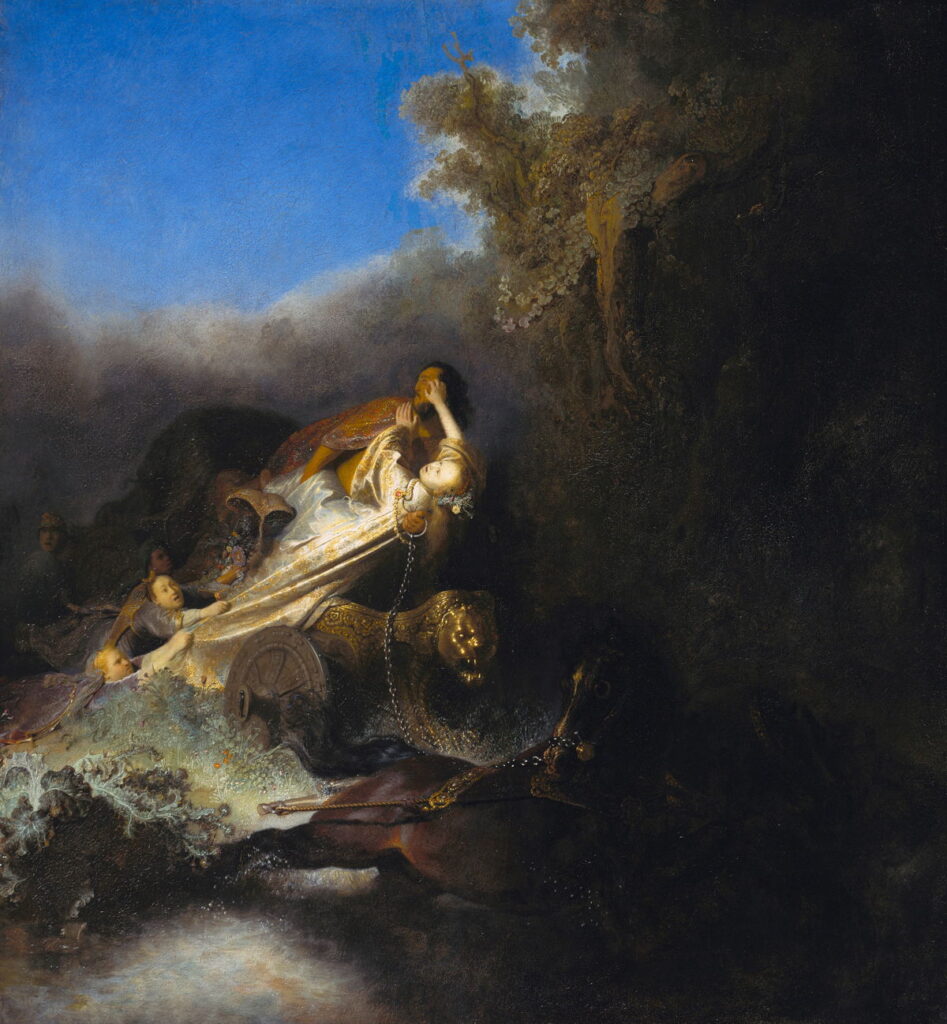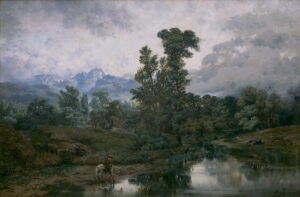Changing Paintings: 22 Proserpine’s fate

Minerva is with the nine Muses on Helicon, where she has just been told the story of their contest with the Pierides, and the Muses offer to repeat the stories that Calliope had sung so successfully in that challenge. The first of these is one of the longest in Ovid’s Metamorphoses, and tells of the rape of Proserpine and its consequences.
Calliope, Muse of epic poetry, introduces and praises Ceres, goddess of the harvest, then abruptly takes us to the island of Sicily, where Mount Etna is an active volcano, and much of her story is set. Living in fear of those eruptions is Pluto, the king of Hades, the underworld, who has left his dark kingdom, and is riding in his chariot to check that all remains well.
Venus sees Pluto, and decides to get her son Cupid to make him fall in love with Ceres’ young daughter Proserpine (Greek Persephone). Cupid selects his finest arrow, which strikes Pluto in the heart. Meanwhile Proserpine is playing and picking flowers in an idyllic spot by Lake Pergus. Pluto draws up in his chariot, takes a fancy to the young girl, and carries her off. As he drives his horses hard to make a fast getaway, she calls on her mother and friends to rescue her and tears her robe in panic.
As Pluto makes off with her in his chariot, they pass a pool where the nymph Cyane lives. She tries to stop them, but Pluto opens up a cleft in the ground, and drives quickly through it down to his kingdom. Cyane is heartbroken, and melts away into a pool formed from her tears of grief, and presumably as blue as the colour of her name.
Artist not known, Hades Abducting Persephone (c 340 BCE), wall painting in the small royal tomb at Verghina (Vergina), Macedonia, Greece. Image © Yann Forget under CC-BY-SA-3.0, via Wikimedia Commons.
This story has been popular among artists since classical times. In a small royal tomb found at Vergina in Macedonia, there is a superb wall-painting of Hades Abducting Persephone dating from 340 BCE. The view above shows the whole of Pluto’s chariot and its horses, while the detail below shows Proserpine being carried by Pluto inside.
Artist not known, Hades Abducting Persephone (detail) (c 340 BCE), wall painting in the small royal tomb at Verghina (Vergina), Macedonia, Greece. Wikimedia Commons.
Niccolò dell’Abbate (1510–1571), The Rape of Proserpine (c 1570), oil on canvas, 196 x 220 cm, Musée du Louvre, Paris. Wikimedia Commons.
Niccolò dell’Abbate’s The Rape of Proserpine (c 1570) gives a fine account of Ovid’s story using multiplex narrative. Under ink-black clouds associated with Hades, Pluto is seen carrying Proserpine up a hill. At the far right, he’s about to drive his chariot into a huge cavern taking them down into his kingdom of Hades. In the foreground, Cyane is by her pool, and about to literally dissolve into tears in its water. Six other nymphs, the daughters of Achelous, are also protesting at the girl’s abduction.
Rembrandt Harmenszoon van Rijn (1606–1669), The Abduction of Proserpina (c 1631), oil on oak panel, 84.8 x 79.7 cm, Gemäldegalerie der Staatlichen Museen zu Berlin, Berlin, Germany. Wikimedia Commons.
Rembrandt’s The Abduction of Proserpina (c 1631) is probably the earliest true masterpiece to show this story, although it deviates from Ovid’s version. Pluto is trying to drive his chariot away, with Proserpine inside it. She’s putting up fierce resistance, though, and trying to fend him off. Hanging on to the hem of Proserpine’s floral dress is a woman who should perhaps be her mother Ceres, but bears the crescent moon normally associated with Diana. Pluto’s chariot is being drawn by two black horses, through an ethereal almost fluid carpet of flowers. The horses and chariot are about to disappear into a black cleft in the earth to make their descent to Hades.
Peter Paul Rubens (1577–1640), The Rape of Proserpina (1636-38), oil on canvas, 180 × 270 cm, Museo Nacional del Prado, Madrid. Wikimedia Commons.
Peter Paul Rubens also shows a composite story, in his superb The Rape of Proserpina (1636-38). Pluto’s face looks the part, his eyes bulging and staring at Minerva, who is trying to stop the girl from being abducted. Below the chariot, the basketful of flowers which Proserpine had been picking is scattered on the ground. Rubens shows irresistible movement to the right, as Pluto struggles to lift the girl into his chariot. Two winged Cupids are preparing to drive the black horses on, once the couple are secured inside.
Joseph Mallord William Turner (1775–1851), The Rape of Proserpine (1839), oil on canvas, 92.6 x 123.7 cm, The National Gallery of Art, Washington, DC. Courtesy of The National Gallery of Art, via Wikimedia Commons.
JMW Turner’s The Rape of Proserpine from 1839 is somewhat the worse for age, probably because of his use of asphalt resulting in severe cracking in its paint layer, and upwelling of lower layers of liquid paint. Proserpine is in the left foreground (detail below), her arms raised in distress as Pluto takes her away in his chariot. To the right are the daughters of Achelous in two groups, and Proserpine’s abandoned basket of flowers.
Joseph Mallord William Turner (1775–1851), The Rape of Proserpine (detail) (1839), oil on canvas, 92.6 x 123.7 cm, The National Gallery of Art, Washington, DC. Courtesy of The National Gallery of Art, via Wikimedia Commons.
Walter Crane (1845–1915), The Fate of Persephone (1878), oil and tempera on canvas, 122.5 × 267 cm, Private collection. Wikimedia Commons.
Walter Crane’s account of The Fate of Persephone (1878) shows the girl at the moment of her abduction, still holding her posy. Pluto is gripping her right arm, ready to move her into the chariot and make off into the future, the dark cavern to the right, which will take the couple down to Hades.
Ceres has missed her daughter, and starts searching the world for her. As it’s getting dark, she looks for somewhere to rest, and knocks on the door of an old woman, who gives her food and drink. While she’s eating, a boy is watching, who then laughs at her and accuses her of being greedy. That angers the goddess, who sprinkles him with her food, and transforms him into a spotted newt.
Ceres continues the search, reaching Cyane’s pool, but after her transformation that nymph is unable to tell what happened. Guessing that her girl had been abducted, Ceres tears her hair and clothing, and her grief destroys Sicily’s harvest.
At last, Arethusa tells Ceres of Pluto’s abduction of her daughter. Ceres goes straight to Jupiter, Proserpine’s father, and pleads the case that the girl should be freed from Hades. Jupiter agrees on the condition set by the Fates that Proserpine has not eaten while she has been in the underworld. Sadly, that proves not to be the case, as she had been seen by Ascalaphus nibbling a pomegranate.
Adam Elsheimer (1578–1610) and Workshop, Ceres at Hecuba’s Home (c 1605), oil on copper plate, 30 × 25 cm, Museo Nacional del Prado, Madrid. Wikimedia Commons.
Few artists have been diverted by the side-stories offered here by Ovid. Adam Elsheimer, though, depicted Ceres at Hecuba’s Home in about 1605: this is believed to be a copy made in his workshop of his original. The young boy is mocking Ceres slaking her thirst during her search for the missing Proserpine.
As the witness, Ascalaphus is transformed into a screech-owl. The daughters of Achelous, water-nymphs who were playing with Proserpine when she was abducted by Pluto, are transformed into the Sirens, half-woman and half-bird, for their inattention to her care.
Jupiter is forced to compromise over the fate of Proserpine, and decrees that she will spend half the year with her mother, and the other half with her husband in Hades. Thus it’s Proserpine’s six months spent with Ceres during which the land is fertile and food can be grown; when she returns to Pluto for the winter, the earth lies barren.
George Wilson (1848-1890), The Spring Witch (c 1880), oil on canvas, 106.7 × 80 cm, Delaware Art Museum, Wilmington, DE. Wikimedia Commons.
George Wilson, an almost unknown Pre-Raphaelite, painted two works based on this myth. His Rape of Proserpine is in a private collection and I have been unable to locate a usable image of it, but The Spring Witch (c 1880) was inspired by Jupiter’s compromise of her spending half the year in Hades, and half above. Wilson shows Proserpine when she has just emerged from Hades, to start her six months sojourn with her mother. She holds a fateful pomegranate in her left hand, from which a magical fibrous band emerges to wind around her body.
Dante Gabriel Rossetti (1828–1882), Proserpine (1882), oil on canvas, 78.7 × 39.2 cm, Birmingham Museum and Art Gallery, Birmingham, England. Wikimedia Commons.
In the late years of Dante Gabriel Rossetti’s career, he became quite obsessed with Proserpine, and from 1871 made at least eight paintings of her. The image above show his last, Proserpine, which he completed shortly before his death in 1882. She stares into the distance, clutching her partly-eaten pomegranate, an oil lamp guttering below. The verses at the top right read:
Afar away the light that brings cold cheer
Unto this wall, – one instant and no more
Admitted at my distant palace-door.
Afar the flowers of Enna from this drear
Dire fruit, which, tasted once, must thrall me here
Afar those skies from this Tartarean gray
That chills me: and afar, how far away,
The nights that shall be from the days that were.
Afar from mine own self I seem and wind
Strange ways in thought, and listen for a sign:
And still some heart unto some soul doth pine,
(Whose sounds mine inner sense is fain to bring,
Continually together murmuring,)
“Woe’s me for thee, unhappy Proserpine”!




